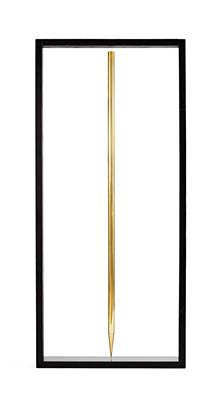Gino de Dominicis *

(Ancona 1947–1998 Rome)
Asta in equilibrio, 1971, signed, dated Gino de Dominicis 1971, signed de Dominicis on the iron inner part, with dedication ‘A Pio’, brass, iron, magnet, glass, painted wood frame, rod 175 cm, diameter 2 cm, frame 186.5 x 84.5 x 12.5 cm, (MCC)
Watch Video: Contemporary Art | November 2015 | Italian Contemporary Art
Provenance:
Acquired from the artist by galleria Pio Monti, Rome, in 1971 (written declaration)
Galleria Pio Monti, Rome, there acquired by the present owner in 2005
Private Collection, Italy
Exhibition:
Rome, Gino de Dominicis, galleria Pio Monti,14 January 1977
Rome, Gino de Dominicis, galleria Pio Monti,14 January 1978
Within the framework of his uninterrupted research concerning the immortality of the body, time, space, invisibility and myth, Gino de Dominicis disappeared on 14 January 1977 and reappeared on 14 January 1978 in the same gallery, where his exhibition still featured the same items, date and invitation. Time had stopped.
As Pio Monti recalls, ‘I can remember the two identical exhibitions, repeated one year apart, on 14 January 1977 / 14 January 1978, with a huge stone, a balancing pole, two small vases representing ubiquity, and an invisible pyramid’
Literature:
I. Tommasoni, Gino de Dominicis, Catalogo ragionato, Skira, Milan, 2011, p. 211, no. 50 with ill. (with wrong date: 1977)
‘A painter is like a conjuror who has to succeed in astonishing himself with his tricks. Here lies the complexity.’
(Gino de Dominicis, “L’Arte e la Biennale” in Quadri & Sculture, n. 33, november/december 1988)
The motif of the balancing pole, shiny and gilt, magically standing on the floor without any apparent support, recurs in many of Gino de Dominicis’ works from 1967 onwards. “Equilibrio 1” [“Balance 1”] appeared in 1969, when it was exhibited at L’Attico Gallery in Rome in what was then the artist’s first solo exhibition. The verticality of the pole is a symbol of the link between earth and heavens, it is an ascending path between the earthly and the divine, a firm, almost immortal point, around which the universe develops.
The poles vary in size according to the space in which they are to be displayed. They are kept in balance by means of the force generated by the magnets placed above them and an iron cylinder installed in the poles themselves. At a later stage, the balancing rod was either placed within a “niche” or a sort of frame, which was either black or white, or it was associated with more complex installations.
In “Il tempo, lo sbaglio, lo spazio” [“Time, Error, Space”] (1969), the pole balanced on the right index finger of a human skeleton on rollerblades lying on the floor, next to the skeleton of his dog on a leash.
In the contemporary art collection at Rivoli Castle, Turin, the pole stood on a large black stone, whilst at Museo di Capodimonte in 1986 the pole on display was white and stood on a red stone. A further example is the monumental 16m pole displayed within the group exhibition “Roma Anni ‘60” [1960s Rome] curated by Maurizio Calvesi and Rossella Siligato at the Palazzo delle Esposizioni in 1990.
Expert: Maria Cristina Corsini
 Maria Cristina Corsini
Maria Cristina Corsini
+39-06-699 23 671
maria.corsini@dorotheum.it
25.11.2015 - 18:00
- Dosažená cena: **
-
EUR 222.600,-
- Odhadní cena:
-
EUR 80.000,- do EUR 120.000,-
Gino de Dominicis *
(Ancona 1947–1998 Rome)
Asta in equilibrio, 1971, signed, dated Gino de Dominicis 1971, signed de Dominicis on the iron inner part, with dedication ‘A Pio’, brass, iron, magnet, glass, painted wood frame, rod 175 cm, diameter 2 cm, frame 186.5 x 84.5 x 12.5 cm, (MCC)
Watch Video: Contemporary Art | November 2015 | Italian Contemporary Art
Provenance:
Acquired from the artist by galleria Pio Monti, Rome, in 1971 (written declaration)
Galleria Pio Monti, Rome, there acquired by the present owner in 2005
Private Collection, Italy
Exhibition:
Rome, Gino de Dominicis, galleria Pio Monti,14 January 1977
Rome, Gino de Dominicis, galleria Pio Monti,14 January 1978
Within the framework of his uninterrupted research concerning the immortality of the body, time, space, invisibility and myth, Gino de Dominicis disappeared on 14 January 1977 and reappeared on 14 January 1978 in the same gallery, where his exhibition still featured the same items, date and invitation. Time had stopped.
As Pio Monti recalls, ‘I can remember the two identical exhibitions, repeated one year apart, on 14 January 1977 / 14 January 1978, with a huge stone, a balancing pole, two small vases representing ubiquity, and an invisible pyramid’
Literature:
I. Tommasoni, Gino de Dominicis, Catalogo ragionato, Skira, Milan, 2011, p. 211, no. 50 with ill. (with wrong date: 1977)
‘A painter is like a conjuror who has to succeed in astonishing himself with his tricks. Here lies the complexity.’
(Gino de Dominicis, “L’Arte e la Biennale” in Quadri & Sculture, n. 33, november/december 1988)
The motif of the balancing pole, shiny and gilt, magically standing on the floor without any apparent support, recurs in many of Gino de Dominicis’ works from 1967 onwards. “Equilibrio 1” [“Balance 1”] appeared in 1969, when it was exhibited at L’Attico Gallery in Rome in what was then the artist’s first solo exhibition. The verticality of the pole is a symbol of the link between earth and heavens, it is an ascending path between the earthly and the divine, a firm, almost immortal point, around which the universe develops.
The poles vary in size according to the space in which they are to be displayed. They are kept in balance by means of the force generated by the magnets placed above them and an iron cylinder installed in the poles themselves. At a later stage, the balancing rod was either placed within a “niche” or a sort of frame, which was either black or white, or it was associated with more complex installations.
In “Il tempo, lo sbaglio, lo spazio” [“Time, Error, Space”] (1969), the pole balanced on the right index finger of a human skeleton on rollerblades lying on the floor, next to the skeleton of his dog on a leash.
In the contemporary art collection at Rivoli Castle, Turin, the pole stood on a large black stone, whilst at Museo di Capodimonte in 1986 the pole on display was white and stood on a red stone. A further example is the monumental 16m pole displayed within the group exhibition “Roma Anni ‘60” [1960s Rome] curated by Maurizio Calvesi and Rossella Siligato at the Palazzo delle Esposizioni in 1990.
Expert: Maria Cristina Corsini
 Maria Cristina Corsini
Maria Cristina Corsini
+39-06-699 23 671
maria.corsini@dorotheum.it
|
Horká linka kupujících
Po-Pá: 10.00 - 17.00
kundendienst@dorotheum.at +43 1 515 60 200 |
| Aukce: | Současné umění |
| Typ aukce: | Salónní aukce |
| Datum: | 25.11.2015 - 18:00 |
| Místo konání aukce: | Wien | Palais Dorotheum |
| Prohlídka: | 14.11. - 25.11.2015 |
** Kupní cena vč. poplatku kupujícího a DPH
Není již možné podávat příkazy ke koupi přes internet. Aukce se právě připravuje resp. byla již uskutečněna.
